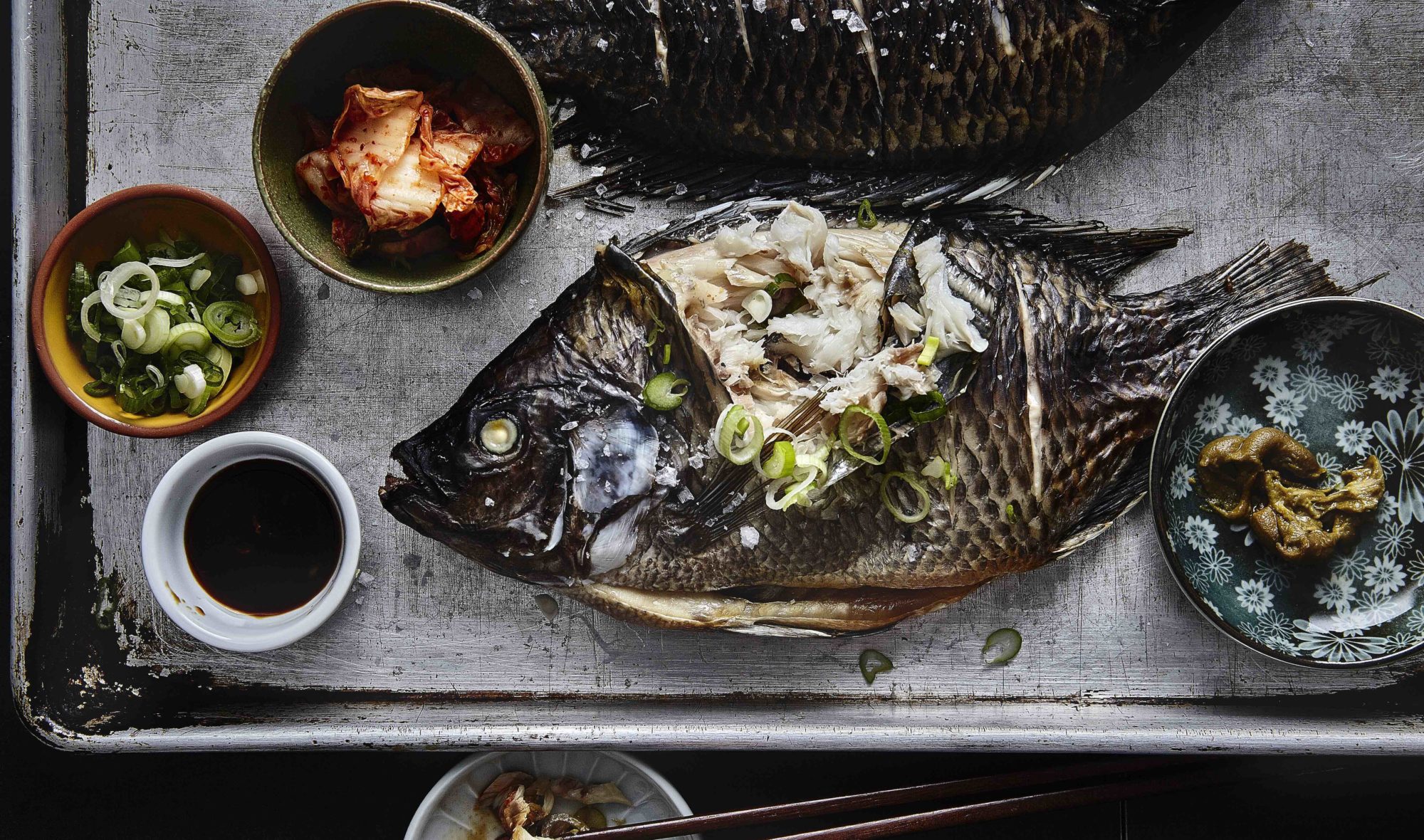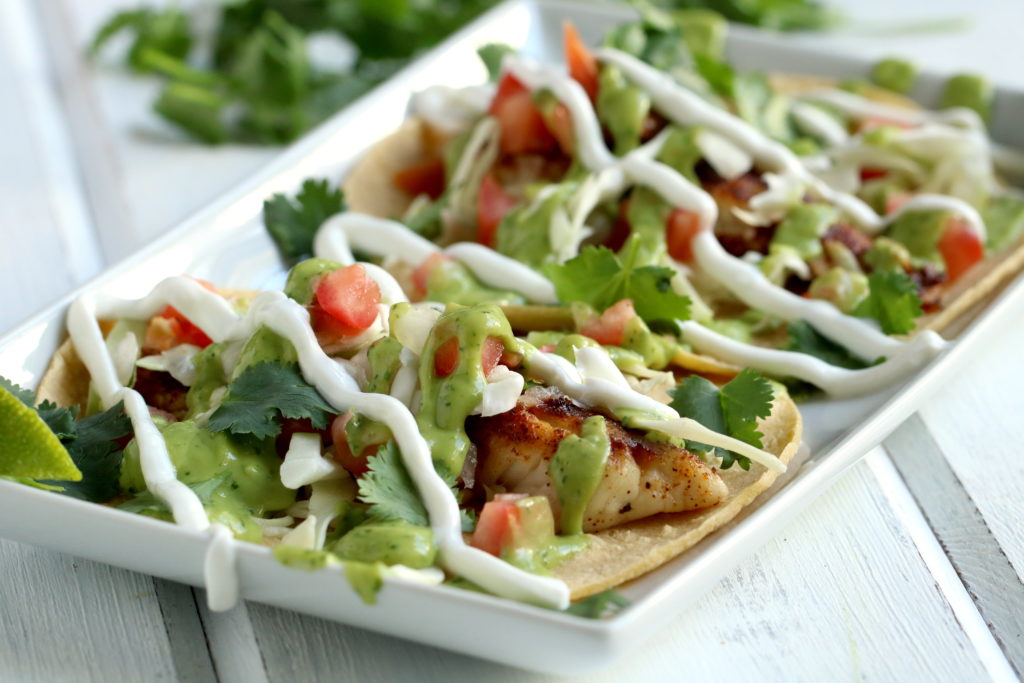
Tilapia is a warm-water-loving freshwater fish with a distinguishing comb-like dorsal fin. With its mild-tasting, white flesh, it’s a great fish for those who don’t like “fishy” flavors. However, because of its mildness, tilapia tends to absorb flavors from its environment and therefore may be prone to an “off” flavor, which may be described as “muddy” or “musty”. This flavor is no indication of quality or freshness and depends on the kind of algae found in the tilapia’s environment. Tilapia is an excellent source of lean protein and is also a rich source of vitamin D, vitamin B12, potassium, and magnesium. Due to its leanness, its short life cycle, and its low position on the food chain, it also tends to be very low in mercury.
Tilapia is a warm-water-loving freshwater fish with a distinguishing comb-like dorsal fin. Tilapia is not just one type of fish but is actually the common name of a range of fish. The three primary commercial species of tilapia include Nile tilapia, blue tilapia, and Mozambique tilapia.
Tilapia is a hardy species that reproduces and consumes prolifically. In a few instances, tilapia have been introduced to new environments to control mosquito populations or algae overgrowth, which they will eat voraciously. Although these interventions often work to control the original invading species, introducing tilapia often provokes a new problem: Too much tilapia. In fact, tilapia is considered to be one the world’s most invasive species.
Because it is vegetarian, lean, and short-lived, tilapia tends not to accumulate mercury. However, depending on its diet, tilapia can be prone to an “off” flavor. This flavor is no indication of quality or freshness and results from the presence of specific types of algae in the tilapia’s environment. However, for obvious reasons, this flavor can turn consumers off.
China and Egypt are the world’s largest producers of tilapia. Tilapia is also farmed widely across the Southern United States.
Tilapia is a mid-size, flattish fish ranging from about 15 to 30 centimeters in length. A distinguishing feature is the broad, comb-like dorsal fin.
Tilapia is typically sold in boneless filets, although they may be sold whole too. The flesh of tilapia is white, and when raw, has a dark pink tinge towards the center.
Tilapia has a soft texture and a mild, minimally fishy flavor. However, like some other types of farmed fish, tilapia is prone to tasting “off”. This flavor, which is described as “muddy” or “musty”, comes from the presence of a specific type of cyanobacteria or algae in the tilapia’s environment. It does not indicate quality or freshness, but for obvious reasons, can turn consumers off.
One filet of cooked tilapia (about 87g) has 111 calories, 22.8g of protein, 2.3g of fat, and no carbohydrates, fiber, or sugar. Tilapia is an excellent source of vitamin D and vitamin B12, and a good source of potassium and magnesium.
In order to choose good quality, fresh tilapia, shop at grocery stores and fish markets that you trust and consistently provide good quality products.
If buying fresh, look for fish, whether whole or in filets, that is kept on ice. The flesh should not be frozen but should remain very cold.
If you can, smell the fish. It should have a pleasant oceanic smell. If it smells fishy, funky, or musky, it’s likely a little old. If you are buying a whole fish, inspect the eyes (which should be clear, not cloudy or slimy) and the scales (which should look shiny and clean, not flaky or peeling).
If buying frozen, look for trusted brands that contain minimal or no additional ingredients.
If the tilapia you have purchased is fresh (not frozen), store it in the fridge for up to 48 hours. However, the flavor and freshness are best if fresh tilapia is cooked the same day of purchase.
If buying frozen tilapia, defer to the directions and expiration date on the package. Generally, if kept well-sealed, frozen tilapia can stay fresh in the freezer for up to three months.
Tilapia should be cooked prior to eating. The easiest way to eat tilapia is to cook it from a fresh filet.
In order to do this, first heat a drizzle of olive oil or a bit of butter in a pan over medium-high heat. Season both sides of the fish with salt and pepper. Wait until the oil is sizzling, and then place the filet in the pan. Cook on one side, about four minutes, and then flip and cook for another four minutes. The fish is cooked when it flakes easily with a fork. If desired, serve with a squeeze of fresh lemon and a sprinkle of fresh chopped parsley or cilantro.

The fresh cut veggies, the lightness of the fish, and the bursting flavor of cilantro make this a light and tasty taco dish.
Prep Time: 25 minutes Cook Time: 10 minutes Yield: 4 servings
For the avocado sauce:
In a food processor blend the avocado, oil, cilantro, lime juice, onion powder, garlic powder, sea salt, and cayenne pepper. Check the consistency and gradually add ¼ cup water. The sauce should be thinned out but still creamy (not liquid). Set aside.
For the fish:
Mix the seasoning in a small bowl. Next, coat both sides of the tilapia pieces. Heat 2 tsp of olive oil in a nonstick pan. Cook for about 5 minutes on each side. The fish should slide apart easily once done.
For the toppings:
While the tilapia is cooking, chop up your toppings of choice (shredded cabbage, diced onion, diced tomato, fresh cilantro, sliced lime).
Assembly:
Warm 8 corn tortillas in the skillet or microwave according to the package.
Divide each tilapia in half lengthwise and add half to each tortilla (2 tortillas per person). Drizzle the avocado sauce over each tortilla. Top with desired toppings of choice. Serve each with a quarter lime.
Precision Nutrition’s Encyclopedia of Food expands every single month as we highlight new foods and showcase beautiful food photography. If you’d like to stay up to date, simply click this link. From there, we’ll send you a FREE copy of our recipe book. We’ll also let you know when new and delicious foods are added to the site.
Tilapia is a warm-water-loving freshwater fish with a distinguishing comb-like dorsal fin. With its mild-tasting, white flesh, it’s a great fish for those who don’t like “fishy” flavors. However, because of its mildness, tilapia tends to absorb flavors from its environment and therefore may be prone to an “off” flavor, which may be described as “muddy” or “musty”. This flavor is no indication of quality or freshness and depends on the kind of algae found in the tilapia’s environment. Tilapia is an excellent source of lean protein and is also a rich source of vitamin D, vitamin B12, potassium, and magnesium. Due to its leanness, its short life cycle, and its low position on the food chain, it also tends to be very low in mercury.